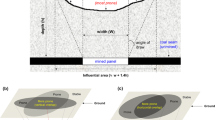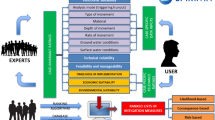Abstract
The Weights-of-Evidence (W-of-E) technique was applied, within a geographic information system (GIS), to derive a model of rockfall potential associated with mining-induced subsidence. The purpose of the model was to describe the potential for rockfalls from up to 60 m high steep sandstone gorges and slopes associated with proposed underground longwall operations within the immediate vicinity of a previously mined area. Ten known rock falls associated with the previous mining operation were used as training points. Six evidential themes were considered-slope, cliff height, planform curvature, profile curvature, the distance of the cliff areas from the longwall panels, and the distance of the cliff areas from the river. Two models were created, one based on a mine layout in which longwall panels extend beneath the steep areas of a nearby river, and a second in which the mine layout is modified so that mining does not occur directly beneath or within 50 m of the steep slopes. This is to allow for the comparison of rockfall potential based on different mining configurations. The results demonstrate that the W-of-E method is a suitable tool for mine subsidence impact assessment, and suggest that not mining directly under the Nepean river may decrease rockfall potential, on average, by approximately ten times. Numerous limitations with the results, relating to the availability of appropriate evidential theme data and the accuracy of training points, are discussed.






Similar content being viewed by others
References
Asadi HH, Hale M (2001) A predictive GIS model for mapping potential gold and base metal mineralization in Takab area, Iran. Comput Geosci 27:901–912
Bonham-Carter GF, Chung CF (1983) Integration of mineral resources data for Kasmere lake area, Northwest Manitoba, with emphasis on uranium. Comput Geosci 15:25–45
Bonham-Carter GF, Agterberg FP, Wright DF (1988) Integration of geological datasets for gold exploration in Nova Scotia. Photogram Eng Remo Sens 54:1585–1592
Bonham-Carter GF, Agterberg FP, Wright DF (1989) Weights of evidence modelling: a new approach to mapping mineral potential. Stat Appl Earth Sci Geol Survey Can Paper 89–9:171–183
Branagan DF, Packham GH (1967) Field geology of New South Wales. Science Press, Sydney
Campbell AN, Holloster VF, Duda RO (1982) Recognition of a hidden mineral deposit by an artificial intelligence program. Science 217:972–929
Carranza EJM, Hale M (2002) Spatial association of mineral occurrences and curvilinear geological features. Math Geol 34:203–221
Cheng Q (2004) Application of weights of evidence method for assessment of flowing wells in the Greater Toronto area, Canada. Nat Resour Res 13:77–86
Daneshfar B, Benn K (2002) Spatial relationships between natural seismicity and faults, southeastern Ontario and north-central New York state. Tectonophysics 353:31–44
Kay D (1991) Effects of subsidence on steep topography and cliff lines. NERDDP Project No. 1446 End of Grant Report, pp 126, Appendices
Kemp LD, Bonham-Carter GF, Raines GL, Looney CG (2001) Arc-SDM: Arcview extension for spatial data modelling using weights of evidence, logistic regression, fuzzy logic and neural network analysis. http://www.ntserv.gis.nrcan.gc.ca/sdm/
Lee S, Choi J (2004) Landslide susceptibility mapping using GIS and the weight-of-evidence model. Int J Geogr Inf Sci 18:789–814
NSW Department of mineral resources (2003) New South Wales coal industry profile.p 257
Sawatzky DL, Raines GL, Bonham-Carter GF, Looney CG (2004) ArcSDM2: ArcMAP extension for spatial data modelling using weights of evidence, logistic regression, fuzzy logic and neural network analysis. http://ntserv.gis.nrcan.gc.ca/sdm/ArcSDM2/
Solomatine DP (2002) Data-driven modelling: paradigm, methods, experiences.In: Proceedings of the 5th international conference on hydroinformatics, Cardiff, UK, 1–5 July 2002 pp 757–763
Spiegelhalter DJ (1986) Uncertainty in expert systems. In: Gale WA (ed) Artificial Intelligence and Statistics. Addison-Wesley, Reading. pp 17–55
Tangestani MH, Moore F (2001) Porphyry copper potential mapping using the weights-of evidence model in a GIS, northern Shahr-e-Babak, Iran. Aust J Earth Sci 48:695–701
Waddington Kay and Associates (2002) Research into the impacts of mine subsidence on the strata and hydrology of river valleys and development of management guidelines for undermining cliffs, gorges and river systems. Report on Australian Coal Association Research Program (ACARP) Project No. C9067, p 186
Young RW, McDougall I (1985) The age extent and geomorphological significance of the Sassafras Basalt, south-eastern New South Wales. Aust J Earth Sci 32:323–331
Acknowledgments
This research was funded by an Australian Coal Association Research Program project (C14031). Daniel Palamara would like to thank Dr. Alexandra Golab for her comments on the original manuscript.
Author information
Authors and Affiliations
Corresponding author
Rights and permissions
About this article
Cite this article
Zahiri, H., Palamara, D.R., Flentje, P. et al. A GIS-based Weights-of-Evidence model for mapping cliff instabilities associated with mine subsidence. Environ Geol 51, 377–386 (2006). https://doi.org/10.1007/s00254-006-0333-y
Received:
Accepted:
Published:
Issue Date:
DOI: https://doi.org/10.1007/s00254-006-0333-y




